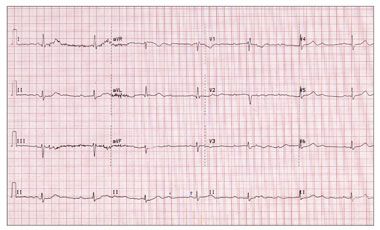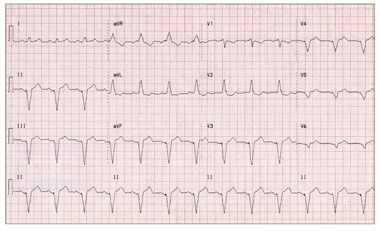- Clinical Technology
- Adult Immunization
- Hepatology
- Pediatric Immunization
- Screening
- Psychiatry
- Allergy
- Women's Health
- Cardiology
- Pediatrics
- Dermatology
- Endocrinology
- Pain Management
- Gastroenterology
- Infectious Disease
- Obesity Medicine
- Rheumatology
- Nephrology
- Neurology
- Pulmonology
Too Much for the Computer: Complete Heart Block in an Elderly Woman
A 92-year-old woman presented with signs and symptoms of heart failure, including marked bilateral lower extremity edema, jugular vein distention, and difficulty in breathing at rest. Her medical history was significant for hyperthyroidism, chronic asthmatic bronchitis, and senile dementia. Medications included oral methimazole, 10 mg/d, and oral theophylline, 200 mg/d.
A 92-year-old woman presented with signs and symptoms of heart failure, including marked bilateral lower extremity edema, jugular vein distention, and difficulty in breathing at rest. Her medical history was significant for hyperthyroidism, chronic asthmatic bronchitis, and senile dementia. Medications included oral methimazole, 10 mg/d, and oral theophylline, 200 mg/d.
An ECG was obtained (Figure 1). The computer interpretation was Wenckebach block (second-degree atrioventricular [AV] block), Mobitz type 1, incomplete right bundle-branch block, and nonspecific ST-segment/T-wave changes.
ECG ANALYSIS
One finding in the first tracing favors second-degree AV block, Mobitz type 1-a constant, regular P-P interval. No other indications for such a diagnosis are present. If it were Wenckebach block, Mobitz type 1, one would see grouped beating (clusters of QRS complexes followed by a ventricular pause), progressive prolongation of the PR interval until a P wave is not conducted (ie, a QRS complex is dropped), and concomitant progressive shortening of the R-R interval.

The P waves are sinus in origin, and the rate is about 100 beats per minute. However, they do not show any relationship with the QRS complexes best seen in the rhythm strip (lead II) at the bottom of the patient’s initial ECG (see Figure 1). The QRS complexes show a regular interval with a ventricular rate of 43 beats per minute. Thus, this is sinus rhythm with third-degree AV block, or complete heart block, complicated by heart failure.
OUTCOME OF THIS CASE
The patient was transferred to a neighboring hospital where she underwent implantation of a permanent dual-chamber pacemaker (DDD mode). The ECG obtained after pacemaker implantation (Figure 2) shows native P waves, sensed by the pacemaker, followed by 100% ventricular pacing and capturing-note that each pacemaker spike is followed by a wide QRS complex. Sensing of native QRS complexes cannot be evaluated because all of the ventricular activity is paced.

After the pacemaker implantation, the patient became asymptomatic and an echocardiogram revealed an ejection fraction of 60%. The third-degree AV block was most likely caused by conduction system disease, possibly in the AV node, as suggested by the QRS complexes, which are narrow on the first tracing.
This case highlights the importance of careful review of the electronic readings on the ECG, because-as demonstrated here-the computer is not infallible.
Kymera's Oral STAT6 Degrader KT-621 Shows Biologic-Like Activity in Early Atopic Dermatitis Trial
December 8th 2025KT-621 achieved deep STAT6 degradation and strong 4-week EASI and itch reductions, offering a potential new oral option for moderate–severe AD and other Th2 inflammation-driven disease.
